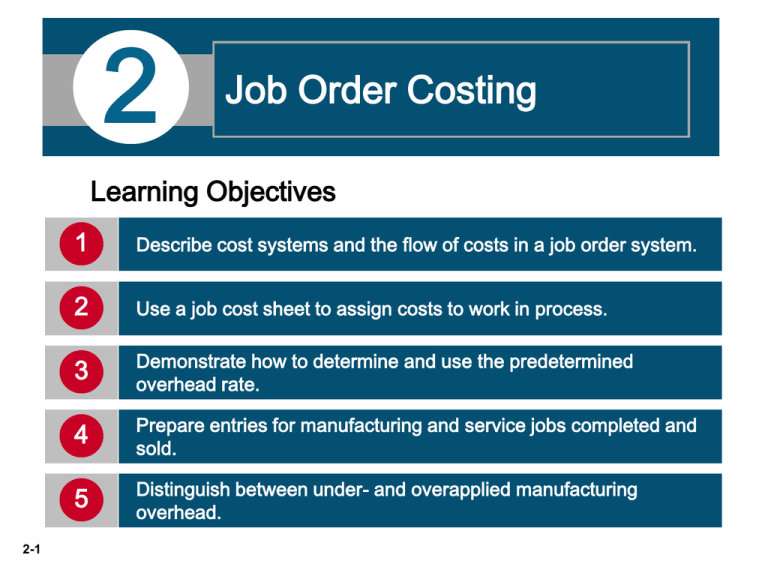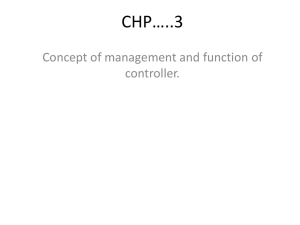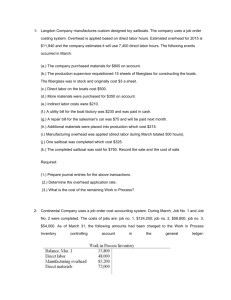
2
Job Order Costing
Learning Objectives
2-1
1
Describe cost systems and the flow of costs in a job order system.
2
Use a job cost sheet to assign costs to work in process.
3
Demonstrate how to determine and use the predetermined
overhead rate.
4
Prepare entries for manufacturing and service jobs completed and
sold.
5
Distinguish between under- and overapplied manufacturing
overhead.
LEARNING
OBJECTIVE
1
Describe cost systems and the flow of
costs in a job order system.
Cost Accounting involves
Measuring,
Recording, and
Reporting product costs.
2-2
Accounts are fully integrated into the general ledger.
Perpetual inventory system provides immediate, up-to-date
information on the cost of a product.
Two basic types: (1) a process order cost system and (2) a
job order cost system.
LO 1
Process Cost System
Used when a large volume of similar products are
manufactured - (cereal, refining of petroleum,
production of ice cream).
Costs are accumulated for a time period – (week or
month).
Costs are assigned to departments or processes for a
specified period of time.
2-3
LO 1
Process Cost System
Illustration 2-1
Process cost system
2-4
LO 1
Job Order Cost System
Costs are assigned to each job or batch.
Important feature: Each job or batch has its own
distinguishing characteristics.
Objective is to compute the cost per job.
Measures costs for each job completed – not for set time
periods.
2-5
LO 1
Job Order Cost System
Illustration 2-2 shows the recording of costs in a job order cost
system for Disney as it produced two different films.
2-6
Illustration 2-2
Job order cost system for Disney
LO 1
2-7
LO 1
Job Order Cost Flow
The flow of costs parallels the physical flow of the materials
as they are converted into finished goods
Manufacturing costs are assigned to the Work in
Process (WIP) Inventory account.
Cost of completed jobs is transferred to the Finished
Goods Inventory account.
When units are sold, the cost is transferred to the Cost
of Goods Sold account.
2-8
LO 1
Job Order Cost Flow
Illustration 2-3
Flow of costs in job
order costing
2-9
Basic overview of the flow of costs in a manufacturing
setting for production of a fire truck.
LO 1
Accumulating Manufacturing Costs
Raw Material Costs
Illustration: Wallace Company purchases 2,000 lithium
batteries (Stock No. AA2746) at $5 per unit ($10,000) and 800
electronic modules (Stock No. AA2850) at $40 per unit
($32,000) for a total cost of $42,000 ($10,000 + $32,000). The
entry to record this purchase on January 4 is:
Jan. 4
Raw Materials Inventory
Accounts Payable
2-10
42,000
42,000
LO 1
Accumulating Manufacturing Costs
Factory Labor Costs
Consists of three costs:
1. Gross earnings of factory workers,
2. Employer payroll taxes on these earnings, and
3. Fringe benefits (such as sick pay, pensions, and vacation
pay) incurred by the employer.
2-11
LO 1
Accumulating Manufacturing Costs
Factory Labor Costs
Illustration: Wallace incurs $32,000 of factory labor costs. Of
that amount, $27,000 relates to wages payable and $5,000
relates to payroll taxes payable in February. The entry to record
factory labor for the month is:
Jan. 31
Factory Labor
32,000
Factory Wages Payable
Employer Payroll Taxes Payable
2-12
27,000
5,000
LO 1
Accumulating Manufacturing Costs
Manufacturing Overhead Costs
Many types of overhead costs
►
For example, property taxes, depreciation, insurance,
and repairs related to the manufacturing process.
Costs unrelated to manufacturing process are expensed.
Costs related to manufacturing process are accumulated
in Manufacturing Overhead account.
►
2-13
Manufacturing overhead subsequently assigned to
work in process.
LO 1
Accumulating Manufacturing Costs
Manufacturing Overhead Costs
Illustration: Using assumed data, the summary entry for
manufacturing overhead in Wallace Manufacturing Company is:
Jan. 31
2-14
Manufacturing Overhead
13,800
Utilities Payable
4,800
Prepaid Insurance
2,000
Accounts Payable (for repairs)
2,600
Accumulated Depreciation
3,000
Property Taxes Payable
1,400
LO 1
1
Accumulating Manufacturing Costs
During the current month, KRT Company incurs the following
manufacturing costs:
(a) Raw material purchases of $4,200 on account.
(b) Factory labor of $18,000. Of that amount, $15,000 relates to
wages payable and $3,000 relates to payroll taxes payable.
(c) Factory utilities of $2,200 are payable, prepaid factory
insurance of $1,800 has expired, and depreciation on the
factory building is $3,500.
Prepare journal entries for each type of manufacturing cost.
2-15
LO 1
1
Accumulating Manufacturing Costs
Prepare journal entries for each type of manufacturing cost.
(a) Raw material purchases of $4,200 on account.
Raw Materials Inventory
4,200
Accounts Payable
4,200
(b) Factory labor of $18,000. Of that amount, $15,000 relates to
wages payable and $3,000 relates to payroll taxes payable.
Factory Labor
Factory Wages Payable
Employer Payroll Taxes Payable
2-16
18,000
15,000
3,000
LO 1
1
Accumulating Manufacturing Costs
Prepare journal entries for each type of manufacturing cost.
(c) Factory utilities of $2,200 are payable, prepaid factory
insurance of $1,800 has expired, and depreciation on the
factory building is $3,500.
Manufacturing Overhead
2-17
7,500
Utilities Payable
2,200
Prepaid Insurance
1,800
Accumulated Depreciation
3,500
LO 1
LEARNING
OBJECTIVE
2
Use a job cost sheet to assign costs to work in
process.
Assigning manufacturing costs to work in process results in
the following entries.
1. Debits made to Work in Process Inventory
2. Credits made to
2-18
►
Raw Materials Inventory
►
Factory Labor
►
Manufacturing Overhead
LO 2
LEARNING
OBJECTIVE
2
Use a job cost sheet to assign costs to work in
process.
Job Cost Sheet
2-19
Used to record costs chargeable to specific jobs.
Constitutes the subsidiary ledger for the work in process
account.
Each entry to Work in Process
Inventory must be accompanied
by a corresponding posting to
one or more job cost sheets.
LO 2
Illustration 2-4
Job cost sheet
2-20
LO 2
Raw Material Costs
Assigned to a job when materials are issued in
response to requests.
Materials requisition slip
►
Written authorization for issuing raw materials.
►
May be directly issued to use on a job - direct
materials (charged to Work in Process Inventory).
►
May be considered indirect materials – charged to
Manufacturing Overhead.
2-21
LO 2
Illustration 2-5
Materials requisition slip
2-22
LO 2
Raw Material Costs
Illustration: Wallace uses $24,000 of direct materials and $6,000 of
indirect materials in January, the entry is:
Jan. 31
Work in Process Inventory
Manufacturing Overhead
Raw Materials Inventory
2-23
24,000
6,000
30,000
LO 2
Raw Material Costs
The sum of the direct
materials columns of
the job cost sheets
should equal the
direct materials
debited to Work in
Process Inventory
account.
2-24
Illustration 2-6
Job cost sheets–posting
of direct materials
Illustration 15-6
LO 2
2-25
LO 2
Factory Labor Costs
2-26
Assigned to jobs on the basis of time tickets.
Time tickets are prepared when the work is performed.
Time tickets indicate:
►
Employee
►
Hours worked
►
Account and job charged
►
Total labor cost
LO 2
Factory Labor Costs
Illustration 2-7
Time ticket
2-27
LO 2
Factory Labor Costs
Illustration: The time tickets are later sent to the payroll
department, which applies the employee’s hourly wage rate and
computes the total labor cost. If the $32,000 total factory labor
cost consists of $28,000 of direct labor and $4,000 of indirect
labor, the entry is:
Jan. 31
Work in Process Inventory
Manufacturing Overhead
Factory Labor
2-28
28,000
4,000
32,000
LO 2
Factory Labor Costs
Jan. 31
Work in Process Inventory
Manufacturing Overhead
Factory Labor
2-29
28,000
4,000
32,000
LO 2
Factory Labor Costs
The sum of the
direct labor
columns of the job
cost sheets should
equal the direct
labor debited to
Work in Process
Inventory.
Illustration 2-8
Job cost sheets–
direct labor
2-30
LO 2
2
Work in Process
Danielle Company is working on two job orders. The job cost
sheets show the following:
Direct materials—Job 120 $6,000; Job 121 $3,600
Direct labor—Job 120 $4,000; Job 121 $2,000
Manufacturing overhead—Job 120 $5,000; Job 121 $2,500
Prepare the three summary entries to record the assignment of
costs to Work in Process from the data on the job cost sheets.
2-31
LO 2
2
Work in Process
Danielle Company is working on two job orders. The job cost
sheets show the following:
Direct materials—Job 120 $6,000; Job 121 $3,600
Direct labor—Job 120 $4,000; Job 121 $2,000
Manufacturing overhead—Job 120 $5,000; Job 121 $2,500
Prepare the three summary entries to record the assignment of
costs to Work in Process from the data on the job cost sheets.
Work in Process Inventory
Raw Materials Inventory
2-32
9,600
9,600
LO 2
2
Work in Process
Danielle Company is working on two job orders. The job cost
sheets show the following:
Direct materials—Job 120 $6,000; Job 121 $3,600
Direct labor—Job 120 $4,000; Job 121 $2,000
Manufacturing overhead—Job 120 $5,000; Job 121 $2,500
Prepare the three summary entries to record the assignment of
costs to Work in Process from the data on the job cost sheets.
Work in Process Inventory
Factory Labor
2-33
6,000
6,000
LO 2
2
Work in Process
Danielle Company is working on two job orders. The job cost
sheets show the following:
Direct materials—Job 120 $6,000; Job 121 $3,600
Direct labor—Job 120 $4,000; Job 121 $2,000
Manufacturing overhead—Job 120 $5,000; Job 121 $2,500
Prepare the three summary entries to record the assignment of
costs to Work in Process from the data on the job cost sheets.
Work in Process Inventory
Manufacturing Overhead
2-34
7,500
7,500
LO 2
LEARNING
OBJECTIVE
3
Demonstrate how to determine and use the
predetermined overhead rate.
Manufacturing Overhead Costs
Relates to production operations as a whole.
Cannot be assigned to specific jobs based on actual
costs incurred.
Companies assign to work in process and to specific jobs
on an estimated basis through the use of a …
Predetermined Overhead Rate
2-35
LO 3
Predetermined Overhead Rate
Based on the relationship between estimated annual
overhead costs and expected annual operating activity.
Expressed in terms of an activity base such as:
►
Direct labor costs
►
Direct labor hours
►
Machine hours
►
Any other measure that will provide an equitable
basis for applying overhead costs to jobs.
2-36
LO 3
Predetermined Overhead Rate
Established at the beginning of the year.
Small companies often use a single, company-wide
predetermined rate.
Large companies often use a different rate for each
department and each department may have a different
activity base.
Formula for computing the predetermined rate
overhead rate is:
2-37
Illustration 2-9
LO 3
Predetermined Overhead Rate
Manufacturing overhead costs are assigned to Work in Process
during the period to get timely information about the cost of a
completed job.
Illustration 2-10
Using predetermined
overhead rates
2-38
LO 3
Predetermined Overhead Rate
Illustration: Wallace Company uses direct labor cost as the activity
base. Assuming that the company expects annual overhead costs
to be $280,000 and direct labor costs for the year to be $350,000,
compute the overhead rate.
This means that for every dollar of direct labor, Wallace will
80 cents of manufacturing overhead to a job.
assign _________
2-39
LO 3
Predetermined Overhead Rate
Illustration: Wallace applies manufacturing overhead to work in
process when it assigns direct labor costs. Calculate the amount of
applied overhead assuming direct labor costs were $28,000.
$28,000 x 80% = $22,400
The following entry records this application.
Jan. 31
Work in Process Inventory
Manufacturing Overhead
2-40
22,400
22,400
LO 3
Predetermined Overhead Rate
The sum of the
manufacturing
overhead columns
of the job cost
sheets should
equal the
manufacturing
overhead debited
(i.e., applied) to
Work in Process
Inventory.
Illustration 2-12
Job cost sheets–
manufacturing
overhead applied
2-41
Predetermined Overhead Rate
At the End of Each Month:
The balance in the Work in Process Inventory should equal the
sum of the costs shown on the job cost sheets of unfinished
jobs.
Illustration 2-13
Proof of job cost sheets to
work in process inventory
2-42
LO 3
3
Predetermined Overhead Rate
Stanley Company produces specialized safety devices. For the
year, manufacturing overhead costs are expected to be
$160,000. Expected machine usage is 40,000 hours. The
company assigns overhead based on machine hours. Job No.
302 used 2,000 machine hours. Compute the predetermined
overhead rate.
Solution
$160,000 ÷ 40,000 hours = $4.00 per machine hour
2-43
LO 3
3
Predetermined Overhead Rate
Stanley Company produces specialized safety devices. For the
year, manufacturing overhead costs are expected to be
$160,000. Expected machine usage is 40,000 hours. The
company assigns overhead based on machine hours. Job No.
302 used 2,000 machine hours. Determine the amount of
overhead to allocate to Job No. 302.
Solution
2,000 hours x $4.00 = $8,000
2-44
LO 3
3
Predetermined Overhead Rate
Stanley Company produces specialized safety devices. For the
year, manufacturing overhead costs are expected to be
$160,000. Expected machine usage is 40,000 hours. The
company assigns overhead based on machine hours. Job No.
302 used 2,000 machine hours. Prepare the entry to assign
overhead to Job No. 302 on March 31.
Solution
Work in Process Inventory
Manufacturing Overhead
2-45
8,000
8,000
LO 3
LEARNING
OBJECTIVE
4
Prepare entries for manufacturing and service
jobs completed and sold.
Assigning Costs to Finished Goods
When a job is
completed,
Wallace
Company
summarizes the
costs and
completes the
lower portion of
the applicable
job cost sheet.
2-46
Illustration 2-14
Completed job
cost sheet
Assigning Costs to Finished Goods
Illustration: When a job is completed, Wallace makes an
entry to transfer its total cost to finished goods inventory.
Jan. 31
Finished Goods Inventory
Work in Process Inventory
2-47
39,000
39,000
LO 4
Assigning Costs to Finished Goods
Illustration: On January 31 Wallace Manufacturing sells on
account Job 101. The job cost $39,000, and it sold for $50,000.
Entries to record the sale and recognize cost of goods sold are:
Jan. 31
Accounts Receivable
50,000
Sales revenue
Cost of Goods Sold
Finished Goods Inventory
2-48
50,000
39,000
39,000
LO 4
Summary of Job Order Cost Flows
Illustration 2-15
Flow of costs in a job
order cost system
2-49
LO 4
Summary of Job Order Cost Flows
Illustration 2-16
Flow of documents in a
job order cost system
2-50
LO 4
Job Order Costing for Service Companies
While service companies do not have inventory, the
techniques of job order costing are still quite useful in many
service-industry environments.
Consider, for example, the Mayo Clinic (health care),
PricewaterhouseCoopers (accounting), and Goldman Sachs
(investment banking).
These companies need to keep track of the cost of jobs
performed for specific customers to evaluate the profitability of
medical treatments, audits, or investment banking
engagements.
2-51
LO 4
2-52
LO 4
Job Order Costing
Advantages
More precise in assignment of costs to projects than
process costing.
Provides more useful information for determining the
profitability of particular projects and for estimating costs
when preparing bids on future jobs.
Disadvantage
2-53
Requires a significant amount of data entry.
LO 4
4
Completion and Sale of Jobs
During the current month, Onyx Corporation completed Job 109
and Job 112. Job 109 cost $19,000 and Job 112 costs $27,000.
Job 112 was sold on account for $42,000. Journalize the entries
for the completion of the two jobs and the sale of Job 112.
Finished Goods Inventory
46,000
Work in Process Inventory
Accounts Receivable
46,000
42,000
Sales Revenue
Cost of Goods Sold
Finished Goods Inventory
2-54
42,000
27,000
27,000
LO 4
LEARNING
OBJECTIVE
5
Distinguish between under- and overapplied
manufacturing overhead.
Illustration 2-17
Cost of goods
manufactured
schedule
2-55
Shows manufacturing overhead applied rather than actual overhead
costs.
Applied overhead is added to direct materials and direct labor to
determine total manufacturing costs
LO 5
Cost of Goods Manufactured
Partial Income Statement
2-56
Illustration 2-18
LO 5
Under- or Overapplied Overhead
A debit balance in manufacturing overhead means
that overhead is underapplied.
A credit balance in manufacturing overhead means
that overhead is overapplied.
Illustration 2-19
Under- and overapplied
overhead
2-57
LO 5
Under- or Overapplied Overhead
Any Year-End Balance in manufacturing overhead is
eliminated by adjusting cost of goods sold.
Underapplied overhead is debited to COGS
Overapplied overhead is credited to COGS
Illustration: Wallace has a $2,500 credit balance in Manufacturing
Overhead at December 31. The adjusting entry for the over-applied
overhead is:
Dec. 31
Manufacturing Overhead
Cost of Good Sold
2-58
2,500
2,500
LO 5
5
Applied Manufacturing Overhead
For Karr Company, the predetermined overhead rate is 140% of
direct labor cost. During the month, Karr incurred $90,000 of factory
labor costs, of which $80,000 is direct labor and $10,000 is indirect
labor. Actual overhead incurred was $119,000. Compute the
amount of manufacturing overhead applied during the month.
Determine the amount of under- or overapplied manufacturing
overhead.
2-59
Manufacturing overhead
applied
(140% x $80,000) = $112,000
Underapplied
manufacturing overhead
($119,000 - $112,000) = $7,000
LO 5
Copyright
Copyright © 2015 John Wiley & Sons, Inc. All rights reserved.
Reproduction or translation of this work beyond that permitted in
Section 117 of the 1976 United States Copyright Act without the
express written permission of the copyright owner is unlawful.
Request for further information should be addressed to the
Permissions Department, John Wiley & Sons, Inc. The purchaser
may make back-up copies for his/her own use only and not for
distribution or resale. The Publisher assumes no responsibility for
errors, omissions, or damages, caused by the use of these
programs or from the use of the information contained herein.
2-60








